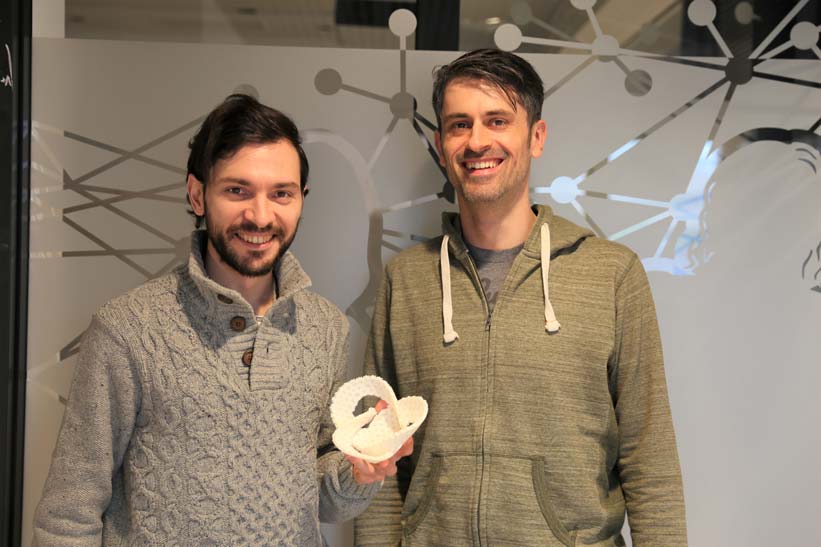January 13, 2020
Geometry meets time: when 2D print-outs fold themselves into complex 3D objects
IST Austria PhD student and computer scientist in collaboration with researchers from Caltech and Rey Juan Carlos University designs flat sheets that transform themselves taking the predefined curved shape with the rates of deformation specified across the whole surface – Study published in Nature Communications

Ruslan Guseinov, PhD student in the Computer Graphics and Digital Fabrication group of IST Austria and Professor Bernd Bickel in collaboration with researchers from Caltech, USA and Rey Juan Carlos University, Spain, successfully demonstrated a novel mechanism of temporal morphing of self-actuated shells. The research is published in the journal Nature Communications.
In his previous project, Ruslan Guseinov demonstrated so called “CurveUps”: flat sheets that transform themselves into smooth-surfaced, free-form objects. Going one step further with the current project, the aspect of time has come into play. How can you ensure that each part of the structure folds at a defined rate? Hereby, two new aspects had to be considered: a mechanism that encodes both time and geometry, and an algorithm to program this “smart” material for a specific target object.
Geometry meets time: Actuation time landscape
A so-called unit cell, the minimal functional element of the 2D sheet, consists of a set of smaller parts with specific roles. The core ingredients are brackets of various thicknesses defining the temporal behavior of the unit cell: the thicker a bracket is, the slower it folds when exposed to a water bath of 56° Celsius. In a first step, the scientists measured the folding time of unit cell samples with different bracket thickness. The collected data was used to build a data-driven model, which serves as a basis for the algorithm allowing the scientists to define which parts of the printed 2D sheet consisting of unit cells should deform faster or slower when exposed to the water bath. As an output, the algorithm provides thin flat lattices to be 3D printed and attached to a pre-stretched membrane which drives the deformation process.
In their publication the scientists demonstrated the new concept “actuation time landscape” with objects of different complexity levels. They developed a software where one can “paint” time landscape directly on top of the target object marking the desired time of deformation completion across the shape. One of the objects to illustrate the new mechanism resembles a flower: to decide which flower petal should fold first, PhD student Guseinov marked petals to morph at different rates and avoid collisions. The deformation process is first simulated by the software, approved, and only then fabricated. The fabricated shell, remaining in a flat state, was then placed in a 56° Celsius water bath to initiate the folding process ranging from 30 to 80 seconds depending on the thicknesses of the unit cells’ brackets. The temporal dependence of the folding process allows the researchers to avoid collisions during the assembly of the flower. Once the resulting object is taken out of water and dries, it stiffens irreversibly and the resulting structure becomes capable of bearing loads.
Complex shapes and potential applications
To further demonstrate the novel mechanism, the Bickel group also demonstrated the new method with designing, printing and assembling a doubly curved shape, a double spiral, and a sheet self-interweaving shape. With its unique behavior, this mechanism offers sturdy structures, for example a mobile stand carrying twice its weight while remaining practically undeformed. PhD student Ruslan Guseinov on his new publication: “We developed new concepts for self-morphing metamaterials with rich functionality to replicate highly non-trivial shapes. In my opinion, this is a significant step toward industrial design of products that autonomously self-assemble on request. I find this exciting and I am very curious to find out how to turn our findings into a viable technology.” Further potential applications could be seen in the medical or aerospace realms, as well as in aesthetically curved furniture with sequentially interlocking joints or the outer shells of aerodynamic drones which is introduced in the publication on a conceptual level.
Publication
Ruslan Guseinov, Connor McMahan, Jesús Pérez, Chiara Daraio & Bernd Bickel. 2020. Programming temporal morphing of self-actuated shells. Nature Communications. DOI:10.1038/s41467-019-14015-2



